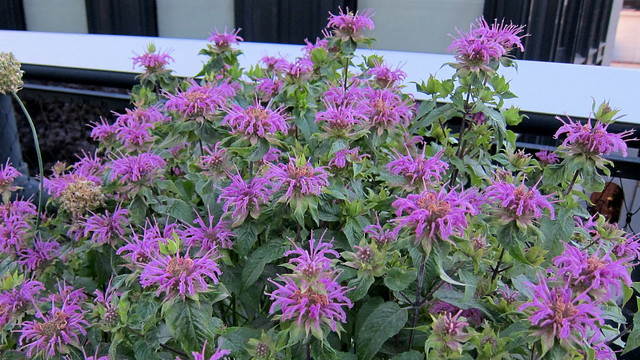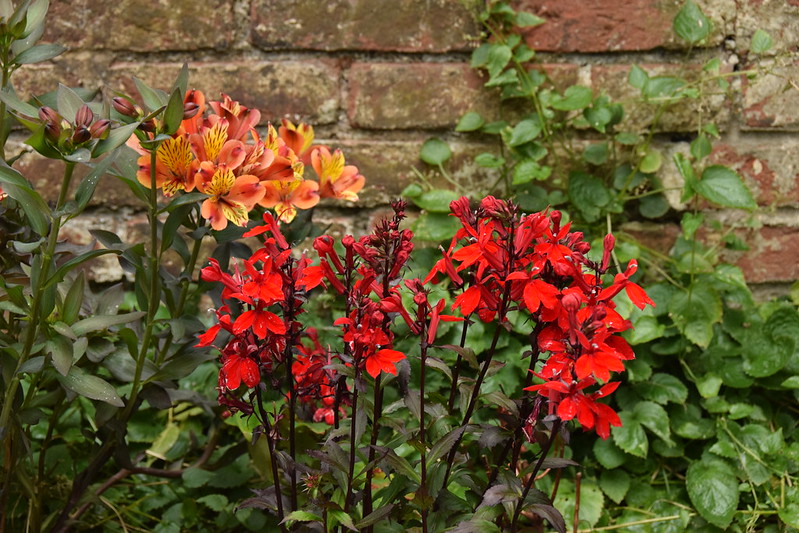The Cultivar Question
While searching for the best plants to include with a garden, you have likely come across cultivars for sale. The use of native cultivars (aka nativars) has been growing as the popularity of native plants surges.

In Mt. Cuba trials, Monarda fistulosa ‘Claire Grace’ was favored by butterflies. Photo by cultivar413 CC by 2.0
What’s in a Name?
To understand more about nativars, you should be aware of the following terms:
Native- a species that was naturally found in a given area. In the United States, we limit that to those species found before European settlement.
Cultivar- a variety of a native species that has been deliberately selected, crossbred or hybridized for desirable characteristics that can be maintained by propagation. Often, these species are represented by the name of the plant with the cultivar variety in apostrophes. Example: garden phlox ‘Jeana’
Straight Species- a native species in its natural form
Nativar- a cultivar of a native species
The use of nativars is varied. Some nativars are bred for showier characteristics while others are designed to resist diseases and pests or to tolerate wider environmental variables, like soil moisture. It is important to note that most nativars are bred for human-valued aesthetics such as number and size of flowers, flowering period and foliage size or color. However, the question looms: are these nativars providing the same wildlife values and ecological functions as straight species? The answer is complex.
Examining the Research
Research examining nativars versus straight species is still a relatively new. In some studies, the species are compared by the number of animal visits while other studies examine nectar and pollen content. Below are summaries from several research studies conducted on nativars:
- A 2015 Penn State trial found that around 50% of the time, the straight species was better than the nativar in terms of the number of pollinator visits. In the experiments, the straight species wild bergamot (Monarda fistulosa) was visited by almost four times more pollinators than the nativar wild bergamot ‘Claire Grace.’ Similarly, the straight species New England aster (Symphyotrichum novae-angliae) had three times more pollinator visits than the nativar New England aster ‘Purple Dome.’ On the flip side, the nativar aromatic aster ‘October Skies’ (Symphyotrichum oblongifolium) had two and a half times more pollinator visits than the straight species, and the nativar threadleaf tickseed (Coreopsis verticillata) ‘Moonbeam’ had twice as many visits than the straight species.
- Missouri Botanical Garden reports that while the nativar serviceberry (Amelanchier canadensis) ‘Glenn Form’ (aka Rainbow Pillar) is typically unaffected by powdery mildew like the straight species, less than 10% of the flowers produce mature fruit.
- Nevison (2016) found that within the garden phlox (Phlox paniculata) group, the cultivar ‘Jeana’ attracted fourteen times the insect abundance as the straight species with over twice the insect diversity. Garden phlox ‘Dick Weaver’ also attracted more insects than the straight species. The worst performing cultivar was garden phlox ‘Volcano Red.’ Eastern tiger swallowtails were the insects encountered the most in the trials and the top two cultivars had similar nectar volume and sugar concentration as the straight species. The cultivar ‘Jeana’ had almost twice as many flowers as the straight species and grew taller as well, two traits which may have enhanced its attractiveness.
- Trials at the Mt. Cuba Center examined the number of pollinator visits on cultivar Monardas versus straight species. Interestingly enough, the cultivar wild bergamot ‘Claire Grace’ which underperformed in Penn State’s trials was favored by butterflies and moths in Mt. Cuba’s trials. In addition, the cultivar bee balm ‘Jacob Cline’ received over 200 more hummingbird visits than the straight species.
- Baisden et al. (2018) compared insect herbivory on woody plant cultivars versus straight native species. Overall, most plants did not have a significant difference in herbivory between the cultivars and straight species. The exceptions included cultivars which had more red or purple (anthocyanin-enriched) leaves. The researchers surmised that the additional anthocyanins made the leaves distasteful.
It is important to note that simply quantifying the number of bee or pollinator visits does not make a plant beneficial to wildlife. For example, White (2016) found that hummingbirds visited commercial hybrid lobelia (Lobelia x speciosa) more often than the straight species of cardinal flower (Lobelia cardinalis). However, when they examined the nectar content, the hybrid only provided 20% of the energy that the hummingbird would get from the straight species. The hybrid was causing hummingbirds to expend more energy to get less food. Future studies are needed to assess the nutritional content of straight species versus nativars.
One additional looming question concerning nativars is how they might affect wild populations of plants if cross pollination occurs. It is possible that cross-pollination may change the gene pool for local plant populations which may have unintended consequences.
Final Thoughts
Overall, it is best to proceed with caution when deciding on whether or not to add nativars to your landscape. When purchasing plants, you should question your supplier on whether or not the plants are straight species or cultivars. When in doubt, opt for the straight species if it is available as that plant is the one that co-evolved with our local wildlife and ecosystems.
If you are like me, you likely have some nativars as part of your current gardens. In some situations, nativars work better for our needs, too, or are more accessible. A nativar is generally better than a non-native species, and it is certainly better than an invasive species!
References:
Baisden, E., D. W. Tallamy and E. Boyle. 2018. Do Cultivars of Native Plants Support Insect Herbivores? HortTechnology. 28(5): 596–606.
Coombs, G. 2016. Monarda for the mid-atlantic region. https://1x848d9mftq5g9wx3epiqa1d-wpengine.netdna-ssl.com/wp-content/uploads/2016/06/Monarda-Report-FINAL.pdf Accessed October 2, 2019.
Holcomb, E. J. and C. Schmotzer. 2015. Bees, Bugs, and Blooms Penn State Extension. https://ento.psu.edu/pollinators/resources-and-outreach/bees-bugs-blooms-2013-a-pollinator-trial Accessed October 2, 2019.
Missouri Botanical Garden. 2019. Amelanchier canadensis ‘Glenn Form’ Rainbow Pillar.. http://www.missouribotanicalgarden.org/PlantFinder/PlantFinderDetails.aspx?taxonid=293359 Accessed October 2, 2019.
Nevison, K. 2016. Considering a role for native plant cultivars in ecological landscaping: an experiment evaluating insect preferences and nectar forage values of Phlox species vs. its cultivars. Unpublished master’s thesis, University of Delaware.
White, A. 2016. From nursery to nature: evaluating native herbaceous flowering plants versus native cultivars for pollinator habitat restoration. Unpublished doctoral thesis, University of Vermont.
Happy Fall!
Fall is my favorite time of year. I love the sights and smells as the summer fades, and it is a great time to be out in the garden. Currently, many animals are in the midst of migration, and we are having some record breaking dragonfly migration swarms this year! As fall unfolds, here are a few things to consider this time of year:
In addition, last year’s rainy summer, coupled with this year’s drought and other factors, have taken a toll on oaks in our region. The University of Maryland Extension has put together an informative and concise article on Why Oak Trees are Declining. If you are in need of trees and shrubs for conservation or lumber, check out the Maryland State Tree Nursery which is accepting orders for Spring 2020.
In this issue, you can learn about a lovely native wildflower, the New England aster, as well as a native group of bees called sweat bees that help to pollinate New England aster and its relatives. In addition, with advances in plant research, we are learning more about how cultivars affect our landscapes. Finally, learn about an up and coming invasive insect in Maryland, the spotted lanternfly, and how to report if you see one in the state.
Happy Habitats,
Kerry Wixted
Click here to have HabiChat—the quarterly backyard wildlife habitat newsletter from the Wild Acres program—delivered right to your inbox!
In this Issue
Native Animal Profile: Sweat Bees (aka Halictid Bees)
Native Plant Profile: New England Aster (Symphyotrichum novae-angliae)
Search and Destroy: the Spotted Lanternfly



 1-888-373-7888
1-888-373-7888 233733
233733